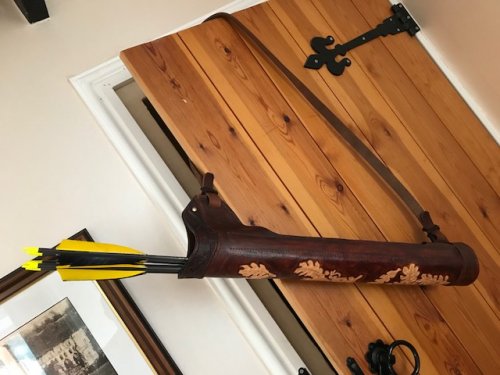Stay Sharp
Well-known member
This Quiver is for the bow I built.
I made a pattern from a piece of padding from when I installed hardwood floors in my dinning room. It is about as thick as the leather I am using but a bit more flexible. It makes a good prototype material.



My biggest concern with having such a big opening in the side of the quiver is that, over time, as the leather softens, it will fold or collapse. I will reinforce the quiver to prevent that from happening.

I am making the quiver out of 8 Oz. tooling leather.

In order to stiffen the sides of the quiver, I stitched long strips of leather to the inside of the quiver.

I left one end open so I could insert 3/32 dia. music wire the entire length of the quiver.


the next step is to at a bit if stiffness and decoration to the opening.

I stitched this piece of 5 Oz. leather to the quiver while flat (before shaping.

The next step is to shape the quiver into it tubular shape. I wetted the leather to allow me to shape the quiver and then used a blow dryer to save a bit of time drying it off. I then marked an overlap and used rubber cement to join the to ends so that I could punch the stitching holes.


With the bottom stitched, I joined both sides of the quiver opening.

Then I cut a slot for the shoulder strap.

Next, I added a piece to the bottom of the quiver that I could attach the other end of the shoulder strap to.


And then gave it a bit of decoration and some stitching holes.


Stitching the already rolled tube proved to be a real pain.


I made a pattern from a piece of padding from when I installed hardwood floors in my dinning room. It is about as thick as the leather I am using but a bit more flexible. It makes a good prototype material.



My biggest concern with having such a big opening in the side of the quiver is that, over time, as the leather softens, it will fold or collapse. I will reinforce the quiver to prevent that from happening.

I am making the quiver out of 8 Oz. tooling leather.

In order to stiffen the sides of the quiver, I stitched long strips of leather to the inside of the quiver.

I left one end open so I could insert 3/32 dia. music wire the entire length of the quiver.


the next step is to at a bit if stiffness and decoration to the opening.

I stitched this piece of 5 Oz. leather to the quiver while flat (before shaping.

The next step is to shape the quiver into it tubular shape. I wetted the leather to allow me to shape the quiver and then used a blow dryer to save a bit of time drying it off. I then marked an overlap and used rubber cement to join the to ends so that I could punch the stitching holes.


With the bottom stitched, I joined both sides of the quiver opening.

Then I cut a slot for the shoulder strap.

Next, I added a piece to the bottom of the quiver that I could attach the other end of the shoulder strap to.


And then gave it a bit of decoration and some stitching holes.


Stitching the already rolled tube proved to be a real pain.



































